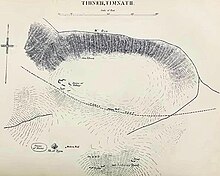Khirbet Tibnah
 | |
| Coordinates | 32°00′30″N 35°06′40″E / 32.00833°N 35.11111°E |
|---|---|
| Grid position | 16035/15725 PAL |
Khirbet Tibnah (also Tibneh[1]), is located on the West Bank, between the villages Deir Nidham and Nabi Salih.
History
Antiquity

Roman and Byzantine periods

Ceramics from the late Roman and the Byzantine eras have been found here (at grid 1603/1573).[3]
On the north slope of the hill south of Khirbet Tibnah lies a Jewish
Crusader period
Khirbet Tibnah is one of the places suggested identified with the Crusader Tyberie.[5]
Ottoman period

In 1596, the Tibnah (Tibya) site was listed as village in the
Both in 1863 and in 1870 Guérin visited, and described several ruins.[8] Khirbet Tibnah is described in 1882 as a tell overlooking a deep valley (Wady Reiya) on the north and the ancient Roman road to the south. A cemetery was situated on a flat hill nearby, and to the northwest, the spring of Ein Tibnah emerged from a rocky channel. On the southwest was an oak tree some 30 or 40 feet high, and two wells, one of them dry. West of the tree were traces of ruins believed to be those of an Arab village.[9]
Mandate period
The village was not inhabited in the late mandatory period.[7]
See also
- Khirbet et-Tibbaneh aka Timnah of Judah, site in the Judaean Mountains
References
- ^ meaning "straw", Palmer, 1881, p. 246
- ^ a b Schürer, 1891, p. 158, note 438.
- ^ Dauphin, 1998, p. 826
- ^ Raviv, Dvir (2017). "שרידים מתקופת בית שני עד מרד בר כוכבא בתל תמנה שבדרום השומרון" (PDF). במעבה ההר. 7 (7): 13–51 – via כתב עת לארכיאולוגיה והיסטוריה של אזור ההר.
- ^ Röhricht, 1887, p. 222; cited in Finkelstein, 1997, p. 367
- ^ Conder and Kitchener, 1882, p. 375
- ^ a b Hütteroth and Abdulfattah, 1977, p. 114
- ^ Guérin, 1875, pp. 89-93
- ^ Conder and Kitchener, 1882, p. 374
Bibliography
- Conder, C.R.; Kitchener, H. H. (1882). The Survey of Western Palestine: Memoirs of the Topography, Orography, Hydrography, and Archaeology. Vol. 2. London: Committee of the Palestine Exploration Fund.
- ISBN 0-860549-05-4.
- ISBN 965-440-007-3. (p. 367)
- Guérin, V. (1875). Description Géographique Historique et Archéologique de la Palestine (in French). Vol. 2: Samarie, pt. 2. Paris: L'Imprimerie Nationale.
- Hütteroth, Wolf-Dieter; Abdulfattah, Kamal (1977). Historical Geography of Palestine, Transjordan and Southern Syria in the Late 16th Century. Erlanger Geographische Arbeiten, Sonderband 5. Erlangen, Germany: Vorstand der Fränkischen Geographischen Gesellschaft. ISBN 3-920405-41-2.
- Palmer, E.H. (1881). The Survey of Western Palestine: Arabic and English Name Lists Collected During the Survey by Lieutenants Conder and Kitchener, R. E. Transliterated and Explained by E.H. Palmer. Committee of the Palestine Exploration Fund.
- Röhricht, R. (1887). "Studien zur mittelalterlichen Geographie und Topographie Syriens". Zeitschrift des Deutschen Palästina-Vereins. 10: 195–344.
- Schürer, E. (1891). Geschichte des jüdischen Volkes im Zeitalter Jesu Christi [A History of the Jewish People in the Time of Jesus Christ]. Vol. 1. Translated by Miss Taylor. New York: Charles Scribner's Sons. p. 158 (note 438).
External links
- Tibneh, Biblewalks
- Survey of Western Palestine, 1880 Map, Map 14: IAA, Wikimedia commons Tibneh (Sheikh et Teim)

